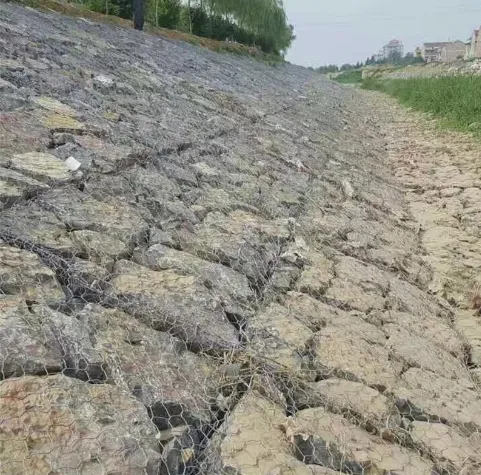Jul . 23, 2025 15:08 Kembali ke daftar
Mastering the Installation of Galvanized Gabion Structures
Galvanized gabion structures, renowned for their durability and versatility, are a cornerstone in modern civil engineering. From erosion control to architectural landscaping, their zinc-coated wire mesh and rock-filled design offer unmatched resilience. For wholesalers and large-scale projects, understanding advanced installation techniques ensures cost efficiency and long-term performance. This guide delves into critical methods, from galvanized gabion mesh handling to securing galvanized gabion baskets, tailored for bulk applications.

Key to maximizing the effectiveness of galvanized gabion structures lies in meticulous planning and execution of the installation process. Proper handling of the galvanized gabion mesh is paramount. It involves unwinding the mesh carefully to avoid kinks or tears, which could compromise the structural integrity. Once unrolled, the mesh should be stretched taut and aligned accurately to ensure even distribution of the rocks once filled. Securing the galvanized gabion baskets is another crucial step. This involves using durable and corrosion-resistant fasteners to anchor the baskets in place. Proper spacing between baskets is essential to allow for adequate drainage and to maintain the overall stability of the structure. Additionally, the baskets should be filled in layers, compacting the rocks as you go to prevent settlement over time.
Understanding Galvanized Gabion Mesh for Structural Integrity
Galvanized gabion mesh forms the backbone of these structures, providing flexibility and corrosion resistance. The zinc coating shields the steel from rust, even in coastal or industrial environments. Key considerations include:
Mesh Types: Hexagonal (double-twist) mesh offers flexibility, ideal for curved surfaces, while welded mesh provides rigidity for vertical retaining walls.
Wire Gauge: For heavy-duty applications like bridge abutments, opt for 4mm-thick wire. Thinner gauges suit decorative or low-stress projects.
Wholesale Handling: Bulk shipments require careful stacking to prevent mesh deformation. Partner with suppliers offering pre-cut panels to reduce on-site labor.
Site Preparation for Optimal Galvanized Gabion Performance
Proper site preparation ensures stability and longevity. Follow these steps for large-scale installations:
Ground Leveling: Use laser-guided equipment to create a flat base, minimizing uneven settling.
Foundation: Compacted gravel or concrete footings prevent subsidence. For soft soils, geotextile fabric adds reinforcement.
Drainage: Integrate perforated pipes behind structures to manage hydrostatic pressure, critical in flood zones.
In a highway project, improper drainage led to gabion wall failure within two years—underscoring the importance of meticulous preparation.
Assembling Galvanized Gabion Baskets: Techniques and Tools
Galvanized gabion baskets arrive flat-packed for efficient transport. Assembly steps include:
Unfolding: Lay panels on a clean surface, avoiding sharp debris that could scratch the zinc coating.
Connecting Sides: Use spiral binders or C-rings to join panels, ensuring vertical and horizontal wires align.
Reinforcing Corners: Add stiffener rods in high-stress areas, like corners or mid-sections, to prevent bulging.
Wholesalers can streamline projects by sourcing pre-assembled galvanized gabion baskets, reducing on-site labor by 30%.
Filling and Securing Galvanized Gabion Structures
Proper filling ensures structural integrity and aesthetic appeal:
Material Selection: Use angular rocks for interlocking stability. Recycled concrete is cost-effective for bulk orders.
Layering: Fill baskets in 1/3 increments, manually compacting each layer to eliminate voids.
Lacing: Secure lids with lacing wire, tensioning evenly to avoid gaps. For wholesale efficiency, pneumatic lacing tools cut installation time by half.
In a landslide mitigation project, improper compaction caused a cost overrun due to subsequent adjustments—a preventable issue with standardized protocols.
FAQ: Solving Common Challenges in Galvanized Gabion Installation
How long do galvanized gabion structures typically last?
With proper installation and maintenance, galvanized gabion structures last 50–100 years.
Can galvanized gabion baskets be customized for unique designs?
Yes. Suppliers offer custom sizes, mesh patterns, and coatings. For bulk orders, modular designs reduce waste and speed up assembly.
Are galvanized gabion cost-effective for large-scale projects?
Absolutely. Bulk purchasing cuts material costs, and their quick assembly reduces labor expenses compared to concrete alternatives.
How do I prevent corrosion at installation sites with galvanized gabion mesh acidic soils?
Menggunakan galvanized gabion mesh with PVC coating and ensure proper drainage to minimize prolonged soil contact.
What tools are essential for wholesale galvanized gabion projects?
Pneumatic lacing tools, rock slingers for filling, and tensioning systems ensure efficiency. Partner with suppliers offering equipment bundles for bulk buyers.
By mastering these techniques, wholesalers can deliver galvanized gabion structures that combine durability, cost savings, and aesthetic versatility—key to winning contracts in competitive markets.
Moreover, emphasizing on training staff to proficiently use these tools further boosts productivity and ensures that projects are completed on time. Adopting a proactive approach to maintenance and regular checks on equipment also minimizes downtime and potential repair costs.Furthermore, fostering a culture of continuous learning within the team allows for the adaptation of new technologies and methodologies as they emerge, keeping the wholesalers at the forefront of industry innovations. By maintaining a high level of equipment efficiency through meticulous maintenance, wholesalers can guarantee a consistent supply of high-quality galvanized gabion structures, enhancing their reputation and attracting more clients.
-
Visualizing Gabion 3D Integration in Urban Landscapes with Rendering
BeritaJul.23,2025
-
The Design and Sustainability of Gabion Wire Mesh Panels
BeritaJul.23,2025
-
The Acoustic Performance of Gabion Sound Barriers in Urban Environments
BeritaJul.23,2025
-
Gabion Boxes: Pioneering Sustainable Infrastructure Across the Globe
BeritaJul.23,2025
-
Custom PVC Coated Gabion Boxes for Aesthetic Excellence
BeritaJul.23,2025
-
Installation Tips for Gabion Wire Baskets in Erosion Control Projects
BeritaJul.21,2025
-
High-Quality Gabion Basket Barriers for Retaining Wall Systems
BeritaJul.21,2025






